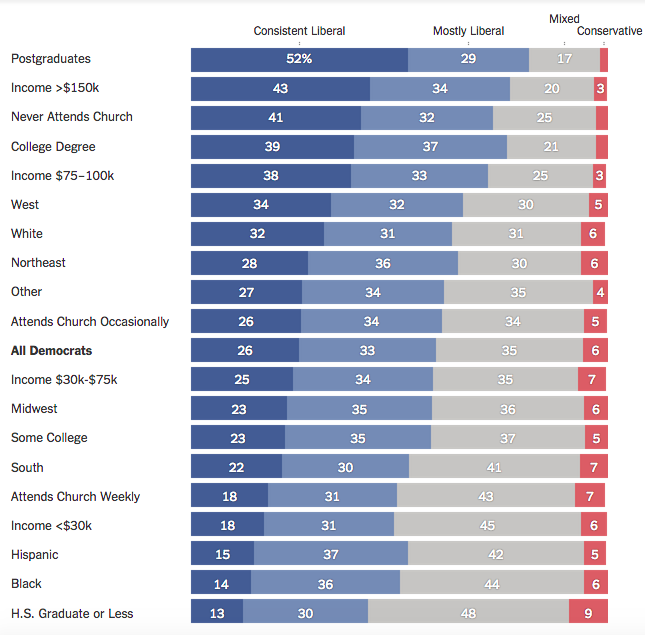At Upshot, Nate Cohn has settled on a very specific line about Bernie Sander (I, II) that I don’t think he argues very well for. The argument in a nutshell is this: Bernie Sanders is very liberal and so he appeals to others who are very liberal, but not to those who are less liberal, such as working class people, Blacks, Hispanics, and so on.
In support of this thesis, Cohn provides this graph based upon Pew political typology data that purports to show what percentage of Democratic-leaning people in each group is a “Consistent Liberal,” “Mostly Liberal,” “Mixed,” or “Conservative.”

The trouble with Cohn’s typology homebrew is that it combines economic and non-economic issues together in judging who is a “consistent liberal” and who isn’t. Certainly rich and college-educated Democrat sorts are much more “liberal” on non-economic issues like gay marriage than working-class, Black, and Hispanic people. But this does not appear to be true for economic issues, which is the primary thing Sanders is running on, much to the chagrin of the highly-educated affluent “Consistent Liberals” that populate the media.
I don’t have access to the Pew microdata to create my own typologies on this (nor the time or interest in doing so). But one easy way to see the issue with Cohn’s approach here is to use two of Pew’s own political typologies: Solid Liberals and Faith & Family Left.
Pew describes Solid Liberals this way:
Highly educated and affluent, Solid Liberals strongly support the social safety net and take very liberal positions on virtually all issues. Most say they always vote Democratic and they are unflagging supporters of Barack Obama. Solid Liberals are very optimistic about the nation’s future and are the most likely to say that America’s success is linked to its ability to change, rather than its reliance on long-standing principles. On foreign policy, Solid Liberals overwhelmingly believe that good diplomacy – rather than military strength – is the best way to ensure peace.
It describes the Faith & Family Left this way:
The Faith and Family Left combine strong support for activist government with conservative attitudes on many social issues. They are highly diverse – this is the only typology group that is “majority-minority.” The Faith and Family Left favor increased government aid for the poor even if it adds to the deficit and believe that government should do more to solve national problems. They oppose same-sex marriage and legalizing marijuana. Religion and family are at the center of their lives.
As with any typology like this, there are always serious grouping problems and some self-sealing problems with the way that one decides to construct the categories. If you make being big into economic populism a threshold requirement of being a “Solid Liberal,” then “Solid Liberals” will always by definition be big into it. Same would be true for the Faith & Family Left. Likewise, if you let people be in the Faith & Family Left even if they weren’t economic populists just because they were anti-war, then you are necessarily going to have a Faith & Family Left that is not as economically populist as the Solid Liberals that entirely screen out non-populists.
Nonetheless, the basic story of these categories is pretty clear: both groups are primarily economically populist, but the Faith & Family Left is conservative on cultural issues while the Solid Liberals is very liberal. These are the screens that are applied in deciding who to allocate to each category.
The demographic result of these screens is very telling. Faith & Family Left is much less white:

The Faith & Family Left has much lower levels of educational attainment:

The Faith & Family Left is much poorer:

So, my point here is that the “Consistent Liberal” versus “Mostly Liberal/Mixed” construction of Cohn likely captures the fact Black, Hispanic, and working class people are not as big into gay marriage, abortion, and that sort of thing. The net effect of this is that Cohn’s analysis basically says that consistent liberal demographic groups will love Bernie more because, unlike the Faith & Family Left, they are huge into the liberal culture war stuff that Bernie almost never talks about. To me, that seems rather strange.
If you believe the various statements Bernie Sanders has made over the years about his electoral strategies, his campaign messaging is in fact calibrated exactly towards these “less liberal” Democrats who are turned on by the left economically, but turned off by it culturally. It’s precariously set up to appeal to the working-class and culturally conservative voter by only speaking to their economic concerns, while actually having waning appeal to the college-educated white liberal who is huge into culture war battles (see the media). This may or may not work (moreover, voters are moved by all sorts of things other than substance). But at minimum, we should at least admit the poverty of an analysis that essentially says Bernie is naturally disadvantaged among groups whose sole interest in liberal politics are the sole topics Bernie talks about.
Cohn’s latest column is titled “What the Hispanic Vote Says About Bernie Sanders’s Chances.” In it, he notes that Obama fared poorly among Hispanics precisely because they aren’t very liberal voters (and would have similarly fared poorly with Blacks if he weren’t himself Black for the same reason). Conspicuously absent from Cohn’s article is any poll numbers about Hispanic support for Bernie. These numbers seem difficult to come by, but I did find one YouGov poll with the appropriate cross-tabulations. In it, 38% of whites support Sanders and 41% of Hispanics support Sanders.